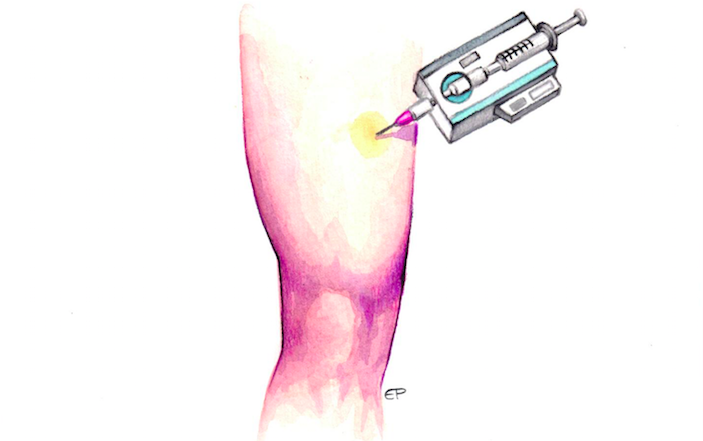How to address acute compartment syndrome (ACS) of the medial thigh in an elderly woman
A 72-year-old female presented to the ED by EMS after a mechanical fall from standing, landing directly on her left knee without sustaining other injuries. The patient complained of 10/10 pain to the left knee and distal medial thigh. She reportedly takes daily aspirin, but was not on any other form of anticoagulation. Physical exam on presentation showed a moderate left knee effusion without laxity in the ligaments and range of motion from approximately 20 to 70 degrees. There was no ecchymosis or changes in the skin.
X-ray of the left knee and femur showed no fracture or dislocation, only soft tissue
swelling to the medial thigh. Approximately 60 minutes later, on re-exam, the patient noted worsening pain and significantly limited range of motion. The left medial thigh was tense as compared to the right and now had bullae. Subsequent CT Angiogram revealed active extravasation from branches of the femoral artery (below).
Acute Compartment Syndrome (ACS) of the Medial Thigh
Much of the body can be divided into compartments which are contained by inelastic fascial membranes. ACS occurs when pressures within a compartment exceed vascular perfusion leading to impaired normal function of tissue [1]. The most common cause of ACS is long bone fracture, though it may also occur secondary to thermal burn, crush injury, casting and other non-traumatic etiologies including infection [1,2,3]. The compartment of the medial thigh contains the gracilis, adductor longus, adductor brevis, adductor magnus muscles, deep femoral artery and vein and the obturator nerve [5].
 Early symptoms of ACS most commonly include pain out of proportion [2]. The physical exam can include pallor, paresthesia, pulselessness, paralysis, and cool extremity but these are late findings in the course of ACS. Early, the only exam finding may be a tense compartment, so clinical suspicion must remain high [1,2,4]. Bullae, as in this patient’s case, may also be present. Direct manometry may serve as an adjunctive measure to clinical diagnosis in the cooperative patient, or as the primary tool for diagnosis in a head injured or obtunded patient [3,5]. Classically a compartment pressure of >30 mmHg was used as a threshold for fasciotomy [1]. However, literature supports that using the measurement of a Delta Pressure (Diastolic – Compartment = Delta) <20-30mmHg is highly indicative of ACS and may be superior to intra-compartmental pressure alone [1,3,4].
Early symptoms of ACS most commonly include pain out of proportion [2]. The physical exam can include pallor, paresthesia, pulselessness, paralysis, and cool extremity but these are late findings in the course of ACS. Early, the only exam finding may be a tense compartment, so clinical suspicion must remain high [1,2,4]. Bullae, as in this patient’s case, may also be present. Direct manometry may serve as an adjunctive measure to clinical diagnosis in the cooperative patient, or as the primary tool for diagnosis in a head injured or obtunded patient [3,5]. Classically a compartment pressure of >30 mmHg was used as a threshold for fasciotomy [1]. However, literature supports that using the measurement of a Delta Pressure (Diastolic – Compartment = Delta) <20-30mmHg is highly indicative of ACS and may be superior to intra-compartmental pressure alone [1,3,4].
The first step in treating ACS is removal of tight fitting clothes, casts, splints and dressings. The extremity should be kept at level with the torso. Blood pressure should be maintained with normal saline, or blood when necessary, as a low diastolic will worsen the Delta Pressure [3,4]. Definitive treatment is fasciotomy
[4]. In our patient’s case, the hemoglobin dropped 2.3 g/dl from the active arterial bleed in her thigh. Trauma surgery took the patient directly to the operating room for ligation of the bleeding vessel and fasciotomy of the medial thigh compartment. The patient stabilized and was dischargeed.
She returned to the emergency department two weeks later with bleeding from the incision site and desquamation of the skin. Ultrasound demonstrated a large subcutaneous collection of fluid. A hematoma was evacuated. The patient was lost to follow up.
REFERENCES
- Elliott KG, Johnstone AJ. Diagnosing acute compartment syndrome. J Bone Joint Surg Br. 2003;85(5):625.
- Suzuki T, Moirmura N, Kawai K, Sugiyama M. Arterial injury associated with acute compartment syndrome of the thigh following blunt trauma. Injury. 2005 Jan;36(1):151-9.
- Olson SA, Glasgow RR. Acute compartment syndrome in lower extremity musculoskeletal trauma. J Am Acad Orthop Surg. 2005;13(7):436.
- Newton EJ, Love J. Acute complications of extremity trauma. Emerg Med Clin North Am. 2007;25(3):751.
- Schwartz JT, Brumback RJ, Lakatos R, et al. Acute compartment syndrome of the thigh. J Bone Joint Surg 1989; 71A:392-400.










